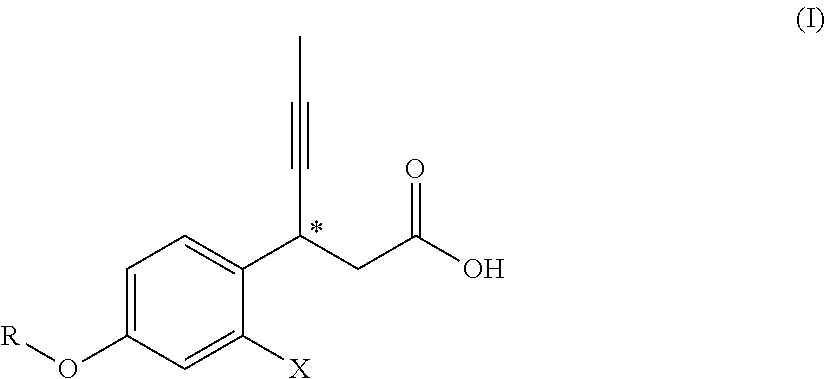3-phenyl-4-hexynoic acid derivatives as gpr40 agonists
a technology of phenyl-4-hexynoic acid and derivatives, which is applied in the field of 3phenyl-4-hexynoic acid derivatives, can solve the problems of further development, further development was abandoned, and the insulin level was raised, so as to achieve comparable or better biological effects, reduce molecular weight, and convenient and practical manufacturing form
- Summary
- Abstract
- Description
- Claims
- Application Information
AI Technical Summary
Benefits of technology
Problems solved by technology
Method used
Image
Examples
examples
[0207]The examples that follow have the illustrative meaning and present commonly used methods of synthesis of intermediate compounds, used for the preparation of the compounds of the invention, final compounds (of the invention) and reference compounds.
[0208]The meaning of abbreviations used in the examples is as follows:
[0209]NMR—is the result of nuclear magnetic resonance spectroscopy (δ means the value of chemical shift in ppm). For 1H NMR spectra the internal standard was tetramethylsilane (TMS). For 13C NMR spectra the internal standard was the value of chemical shift of the solvent signal, which for deuterochloroform (CDCl3) is 77.16 ppm, and for hexadeuterodimethylsulfoxide (DMSO-d6) is 39.52 ppm.
[0210]MS is the result of mass spectroscopy expressed as m / z ratio. The measurements were performed using electrospray ionization technique (ESI) and ions formed were observed as positive ions (ESI+) or negative ions (ESI−). Symbol M for each compound designates molecular ion, obtai...
example i1
romethyl)phenyl]-4-(trifluoromethyl)benzene
[0228]
[0229]{3-[4-(Trifluoromethyl)phenyl]phenyl}methanol, obtained as described below in Example I2 (1.5 g, 5.95 mmol), was dissolved under argon atmosphere in 10 ml of anhydrous dichloromethane to which 1.29 ml (17.8 mmol) of thionyl chloride were slowly added dropwise while stirring. After stirring overnight, the solvents and the excess of thionyl chloride were distilled off under reduced pressure. After purification by chromatography (silica gel 60, 230-400 mesh, eluent: gradient from n-hexane 100% to n-hexane-dichloromethane 4:1), colorless solid was obtained (1.04 g, yield 65%).
[0230]1H NMR (300 MHz, CDCl3) δ: 7.69 (s, 4H), 7.61 (s, 1H), 7.55 (dt, J=7.3, 1.8 Hz, 1H), 7.50-7.40 (m, 2H), 4.65 (s, 2H).
example i2
fluoromethyl)phenyl]phenyl}methanol
[0231]
[0232]Obtained according to the method described in J. B. Houze et al., “AMG 837: A potent, orally bioavailable GPR40 agonist”, Bioorganic and Medicinal Chemistry Letters. 22 (2012) p. 1267-1270. Spectral data were consistent with literature data, for example WO 2005 / 118542 A1, example 11, page 50:[0233]1H NMR (300 MHz, CDCl3) δ: 7.68 (s, 4H), 7.60 (s, 1H), 7.51 (dt, J=7.5, 1.6 Hz, 1H), 7.48-7.36 (m, 2H), 4.76 (s, 2H).
PUM
| Property | Measurement | Unit |
|---|---|---|
| structure | aaaaa | aaaaa |
| hydrophobic | aaaaa | aaaaa |
| length | aaaaa | aaaaa |
Abstract
Description
Claims
Application Information
 Login to View More
Login to View More - R&D
- Intellectual Property
- Life Sciences
- Materials
- Tech Scout
- Unparalleled Data Quality
- Higher Quality Content
- 60% Fewer Hallucinations
Browse by: Latest US Patents, China's latest patents, Technical Efficacy Thesaurus, Application Domain, Technology Topic, Popular Technical Reports.
© 2025 PatSnap. All rights reserved.Legal|Privacy policy|Modern Slavery Act Transparency Statement|Sitemap|About US| Contact US: help@patsnap.com



